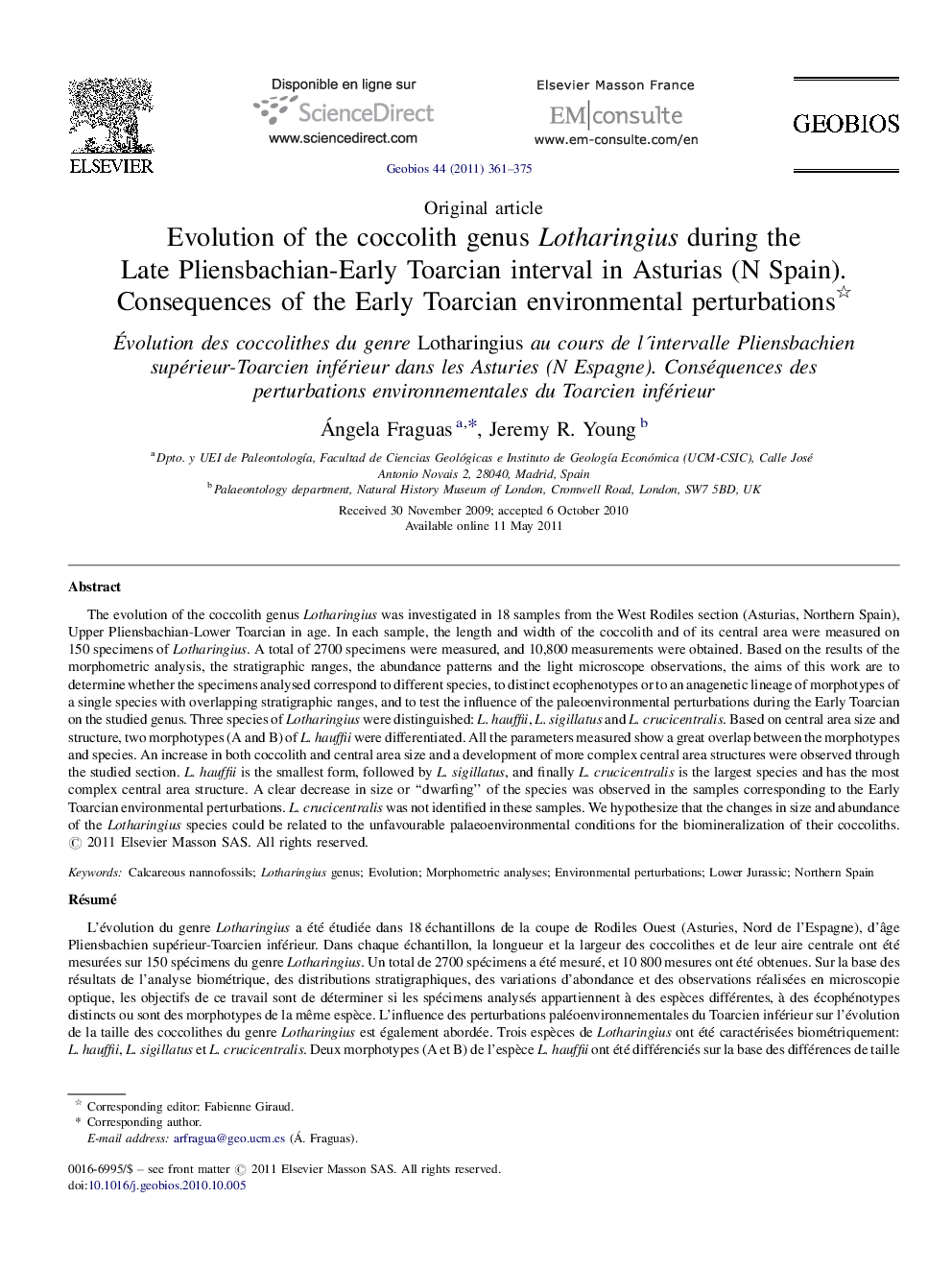| کد مقاله | کد نشریه | سال انتشار | مقاله انگلیسی | نسخه تمام متن |
|---|---|---|---|---|
| 4748278 | 1360095 | 2011 | 15 صفحه PDF | دانلود رایگان |

The evolution of the coccolith genus Lotharingius was investigated in 18 samples from the West Rodiles section (Asturias, Northern Spain), Upper Pliensbachian-Lower Toarcian in age. In each sample, the length and width of the coccolith and of its central area were measured on 150 specimens of Lotharingius. A total of 2700 specimens were measured, and 10,800 measurements were obtained. Based on the results of the morphometric analysis, the stratigraphic ranges, the abundance patterns and the light microscope observations, the aims of this work are to determine whether the specimens analysed correspond to different species, to distinct ecophenotypes or to an anagenetic lineage of morphotypes of a single species with overlapping stratigraphic ranges, and to test the influence of the paleoenvironmental perturbations during the Early Toarcian on the studied genus. Three species of Lotharingius were distinguished: L. hauffii, L. sigillatus and L. crucicentralis. Based on central area size and structure, two morphotypes (A and B) of L. hauffii were differentiated. All the parameters measured show a great overlap between the morphotypes and species. An increase in both coccolith and central area size and a development of more complex central area structures were observed through the studied section. L. hauffii is the smallest form, followed by L. sigillatus, and finally L. crucicentralis is the largest species and has the most complex central area structure. A clear decrease in size or “dwarfing” of the species was observed in the samples corresponding to the Early Toarcian environmental perturbations. L. crucicentralis was not identified in these samples. We hypothesize that the changes in size and abundance of the Lotharingius species could be related to the unfavourable palaeoenvironmental conditions for the biomineralization of their coccoliths.
RésuméL’évolution du genre Lotharingius a été étudiée dans 18 échantillons de la coupe de Rodiles Ouest (Asturies, Nord de l’Espagne), d’âge Pliensbachien supérieur-Toarcien inférieur. Dans chaque échantillon, la longueur et la largeur des coccolithes et de leur aire centrale ont été mesurées sur 150 spécimens du genre Lotharingius. Un total de 2700 spécimens a été mesuré, et 10 800 mesures ont été obtenues. Sur la base des résultats de l’analyse biométrique, des distributions stratigraphiques, des variations d’abondance et des observations réalisées en microscopie optique, les objectifs de ce travail sont de déterminer si les spécimens analysés appartiennent à des espèces différentes, à des écophénotypes distincts ou sont des morphotypes de la même espèce. L’influence des perturbations paléoenvironnementales du Toarcien inférieur sur l’évolution de la taille des coccolithes du genre Lotharingius est également abordée. Trois espèces de Lotharingius ont été caractérisées biométriquement: L. hauffii, L. sigillatus et L. crucicentralis. Deux morphotypes (A et B) de l’espèce L. hauffii ont été différenciés sur la base des différences de taille et de structure de leur aire centrale. Tous les paramètres mesurés présentent un recoupement important entre les morphotypes et les espèces considérés. Une augmentation de la taille des coccolithes et un développement de structures de plus en plus complexe ont été observés dans les échantillons étudiés. L. hauffii est la plus petite forme, suivie par L. sigillatus, puis L. crucicentralis qui est l’espèce de plus grande taille, présentant une structure plus complexe de son aire centrale. Dans les échantillons situés dans l’intervalle où les sédiments sont enrichis en matière organique, une diminution nette de la taille des espèces considérées a été observée ; L. crucicentralis n’a pas été observé dans ces échantillons. Nous suggérons que les changements de taille et d’abondance des espèces du genre Lotharingius pourraient être liés aux conditions paléoenvironnementales défavorables à la biominéralisation des coccolithes.
Journal: Geobios - Volume 44, Issue 4, July–August 2011, Pages 361–375